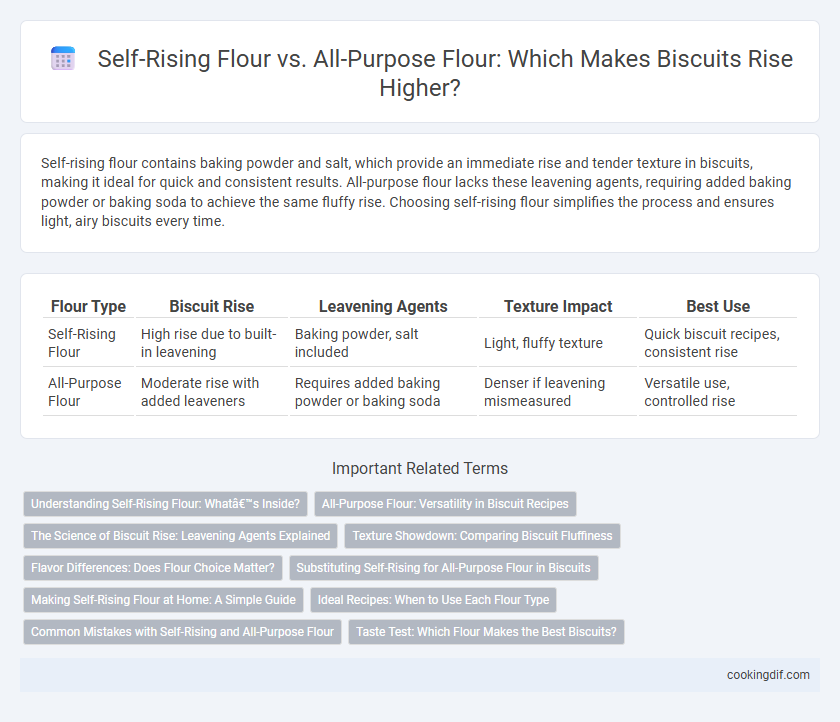Self-rising flour contains baking powder and salt, which provide an immediate rise and tender texture in biscuits, making it ideal for quick and consistent results. All-purpose flour lacks these leavening agents, requiring added baking powder or baking soda to achieve the same fluffy rise. Choosing self-rising flour simplifies the process and ensures light, airy biscuits every time.
Table of Comparison
| Flour Type | Biscuit Rise | Leavening Agents | Texture Impact | Best Use |
|---|---|---|---|---|
| Self-Rising Flour | High rise due to built-in leavening | Baking powder, salt included | Light, fluffy texture | Quick biscuit recipes, consistent rise |
| All-Purpose Flour | Moderate rise with added leaveners | Requires added baking powder or baking soda | Denser if leavening mismeasured | Versatile use, controlled rise |
Understanding Self-Rising Flour: What’s Inside?
Self-rising flour contains a precise blend of refined wheat flour, baking powder, and salt, designed to provide consistent leavening for biscuits without the need for additional rising agents. The baking powder, typically present at about 1 to 1.5 teaspoons per cup of flour, releases carbon dioxide during mixing and baking, creating a light, airy texture essential for biscuit rise. In contrast, all-purpose flour lacks these leavening components, requiring separate additions of baking powder or baking soda and salt to achieve similar biscuit height and fluffiness.
All-Purpose Flour: Versatility in Biscuit Recipes
All-purpose flour provides versatility in biscuit recipes by allowing bakers to control the rise through the addition of baking powder or baking soda. Its balanced protein content creates a tender yet sturdy biscuit texture adaptable to various flavor and moisture levels. Using all-purpose flour enables customization in leavening and consistency, making it ideal for achieving optimal biscuit rise and texture.
The Science of Biscuit Rise: Leavening Agents Explained
Self-rising flour contains baking powder and salt, providing a consistent chemical leavening that reacts with moisture and heat to create carbon dioxide bubbles, resulting in a higher and fluffier biscuit rise. All-purpose flour lacks these leavening agents, requiring separate addition of baking powder or baking soda to activate the leavening process. The science of biscuit rise relies on these agents producing gas that expands pockets in the dough, ensuring light texture and optimal volume.
Texture Showdown: Comparing Biscuit Fluffiness
Self-rising flour contains baking powder and salt, giving biscuits an immediate rise and a lighter, fluffier texture ideal for quick baking. All-purpose flour lacks these leavening agents, requiring added baking powder or baking soda to achieve similar fluffiness and a tender crumb. Using self-rising flour often results in softer, airier biscuits with a more delicate texture, while all-purpose flour provides better control over rise and density depending on added ingredients.
Flavor Differences: Does Flour Choice Matter?
Self-rising flour contains baking powder and salt, giving biscuits a lighter, fluffier texture with a subtly tangy flavor, while all-purpose flour results in a denser biscuit with a more neutral, bready taste. The leavening agents in self-rising flour enhance rise and contribute to a slightly saltier, more complex flavor profile. Choosing between the two flours affects not only the biscuit's height but also its depth of flavor, making flour choice important for specific taste preferences.
Substituting Self-Rising for All-Purpose Flour in Biscuits
Substituting self-rising flour for all-purpose flour in biscuits affects the rise due to the added leavening agents and salt in self-rising flour. When using self-rising flour, it is crucial to omit baking powder and reduce salt to prevent over-leavening and a salty taste. This substitution creates a lighter, fluffier biscuit texture by providing consistent rising power not inherently present in all-purpose flour.
Making Self-Rising Flour at Home: A Simple Guide
Self-rising flour contains baking powder and salt, which provide the necessary leavening agents for biscuits to rise without additional ingredients. To make self-rising flour at home, combine 1 cup of all-purpose flour with 1 1/2 teaspoons of baking powder and 1/4 teaspoon of salt, ensuring even distribution for optimal biscuit texture. This DIY blend delivers consistent rise and tender crumb, enhancing homemade biscuit quality without store-bought mixes.
Ideal Recipes: When to Use Each Flour Type
Self-rising flour contains baking powder and salt, making it ideal for quick biscuit recipes where a light, fluffy rise is desired without extra leavening agents. All-purpose flour requires adding baking powder and salt separately, providing greater control over texture and rise in recipes needing more customized adjustments. Use self-rising flour for simple, fast biscuits and all-purpose flour when precision in rise and flavor balance is prioritized.
Common Mistakes with Self-Rising and All-Purpose Flour
Using self-rising flour instead of all-purpose flour in biscuit recipes often leads to excessive rising and a salty taste due to its pre-added leavening agents and salt. All-purpose flour requires additional baking powder and salt for proper rise, but mismeasuring these ingredients can result in dense or flat biscuits. Understanding the leavening differences and accurately adjusting measurements prevents common mistakes and ensures optimal biscuit texture and flavor.
Taste Test: Which Flour Makes the Best Biscuits?
Self-rising flour contains baking powder and salt, which contributes to a lighter and fluffier biscuit texture compared to all-purpose flour, which requires separate leavening agents. Taste tests often reveal that biscuits made with self-rising flour have a subtly tangy flavor and a more tender crumb, enhancing the overall eating experience. In contrast, all-purpose flour biscuits offer a denser bite with a more neutral flavor profile, allowing more control over rise and seasoning but potentially sacrificing some softness.
Self-rising flour vs all-purpose flour for biscuit rise Infographic

 cookingdif.com
cookingdif.com